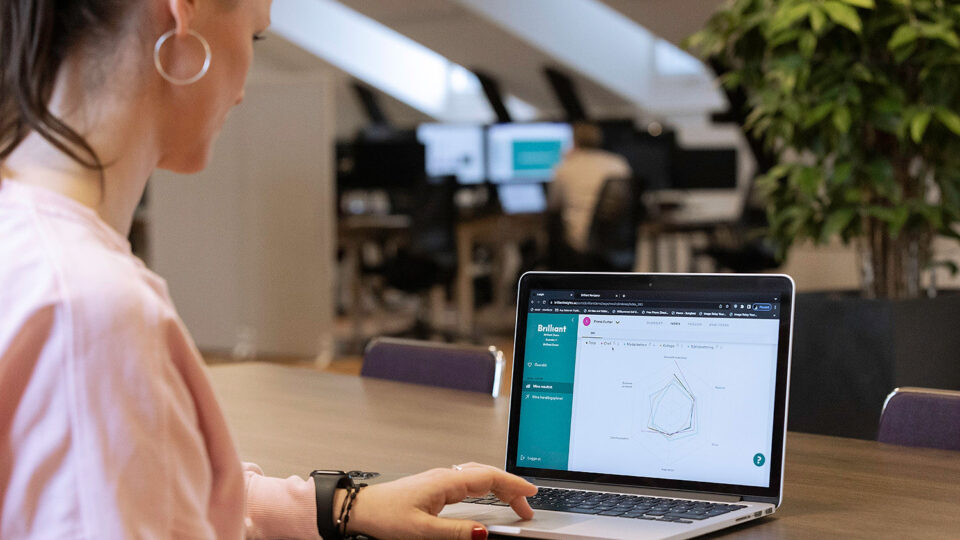This is a question often asked by boards as they consider what the CEO and management need to pursue, but also by HR when they realise that the leadership they have right now doesn’t really match the leadership the employees want. Why does this happen?
Negative trend for the leadership index
The hundreds of thousands of responses from employee surveys conducted by Brilliant in 2022 show a negative trend for the leadership index in many organisations. The index covers the way management teams set out a clear direction of travel and ensure that the organisation is equipped to handle global changes, as well as the way they inform and communicate with their various stakeholders. It should also be noted that the eNPS (whether you are considered an attractive employer) is also on a downward trajectory.
How is all this related? What is the difference between teams that perform well on the above indices and those that perform poorly on them?
Having had the privilege of going into several organisations to find out what employees think, I can summarise the situation as follows:
- Relationship and clarity combined. The organisations with the highest scores on all the questions and indices in the employee survey are those with leaders who manage and distribute the work in a clear and trusted way, as well as drawing on the knowledge of employees on issues of detail. They are good at mapping out the path and showing a clear direction, they lead with confidence in the knowledge of employees and they create an environment where employees feel that they can get involved and exert influence, they are listened to and they can delegate responsibility which they then lead, monitor and give positive feedback on.
- The new normal: successful leaders are able to adapt themselves and their leadership to the current situation, listen, adjust and then take the next step together with their employees. As a leader, you need the ability to match yourself and your leadership to the situation in question. One example right now is about getting the team together via the new digital tools, but also making it worth meeting IRL. Identify the current situation, adjust and take the next step. Lead as the situation dictates.
- Pride and meaningfulness. Leading by building a sense of being part of something bigger is also a vital skill at this point in time. Clarity, but also getting everyone to appreciate what they contribute to the big picture – to feel pride in the organisation, in what they do as individuals, but also in each other.
This is not exactly news – it is what all the data shows, but as the world gets shaken up, it seems that this has become more important to employees, and leaders don’t really know how to handle it.
How can we know what our leaders are good at and what they can improve on so that they can lead our business into the future?
One way is to take stock of the leadership by conducting a 360° survey. 360° Feedback is a tool where the manager/respondent receives feedback from four different perspectives: the perspective of their immediate manager, the perspective of their employees, their own perspective on their leadership, and their colleagues’ perspective on their leadership.
The benefit of this from an organisational point of view is that it turns the spotlight firmly on the leadership. This is an important approach that encourages everyone on their journey of personal and professional development. It also generates information about the current situation so that decisions can be made about what we are already good at in terms of leadership and what we need to develop to achieve our commercial objectives.
360° Feedback is a survey of the current situation, providing a chance to reflect on how the leadership is working right now, and from different perspectives.
A leader needs to understand their target group and be able to lead from different perspectives. Employees need leadership based on their work and current situation, while a manager has a different perspective, i.e. how the respondent functions in the working relationship and perhaps also as a member of the management team, and then colleagues have a third perspective.
Often it is the colleagues who have the hardest time answering, but the question then is how much they should be aware of, in order for leaders to jointly lead the organisation towards the goals of the business plan. We often hear about leaders and management teams working in silos, so they have no idea about how the respondent leads. Is that a good or bad thing? It depends, of course, on the context, but if you are to jointly lead the business towards its objective, consensus among the leadership, leading in a clear direction and seeing each other can make it easier, and then the collegial perspective is crucial.
The answers from the respondents themselves are interesting to look at from the perspective of consensus with others and self-awareness. Leaders don’t always get much feedback, so it can be difficult to change on that basis. However, the responses provide a sound platform for discussions about what the person finds easy, their strengths in leadership, what they find difficult and what needs to be developed, but above all, it is an excellent starting point for an action plan that takes the leader and the team to the next level.

Brilliant’s 360° Feedback has five different dimensions that we know are important for leading an organisation towards its objective, and these form the basis of Brilliant’s leadership model.
The dimensions are:
- Relationships
- Implementation
- Strategy
- Inspiration
- Communication
Each dimension has 5–6 questions in each. The model can also be adapted to your organisation’s own leadership criteria.
A 360° survey gives a good overview of your leadership right now, but it also allows you to create a plan to secure the leadership you need for the future and to develop it based on your needs. It also provides you with useful data to inform your decision-making.
The results are compiled in a report and should be gone through with a licensed consultant. Feedback is easier with an independent consultant, as you don’t have to defend your results but can review them in a safe environment and be encouraged to confidently take the next step. It is important to jointly formulate goals and a concrete action plan going forward.
What is the answer to future leadership?
Brilliant’s data shows that the leadership of the future needs curiosity, a willingness to change, a desire to improve and to be able to use all the knowledge around them to lead and develop the business.
As a leader, you don’t have to know everything yourself, but you need to understand and be able to manage change, and you need to start by understanding yourself.
One example is “going back to the office”. I believe that the leaders who manage to find a new way to collaborate, taking the lessons they have learned from teleworking, digitalisation and being part of this digital revolution, in combination with meaningfulness and the realisation that the world is uncertain – they will be able to lead in a digilogue way, using a range of different tools. Where appropriate and where we have to meet IRL, work will take place in the office, with purposes that are crystal clear, while effective digital meetings will be used as required, perhaps short ones that build trust and clarity and are interactive.
It will become abundantly clear when people should be working remotely in a focused way because it is best for the business. All situations must be put in context and fit the organisation’s objectives, conditions and opportunities. The set-up will vary and employees will, as they already do, need to decide what form they want their working life to take. Some like to be in the office, some like to work remotely and most seem to like a combination of the two.
If leaders and management are clear about which way of working they think is most important to achieve the objective, employees can decide whether this is how they want their future working life to be.
Be careful about HOW you communicate this so that you can retain and recruit your talent. Because the hybrid workplace is here to stay.
